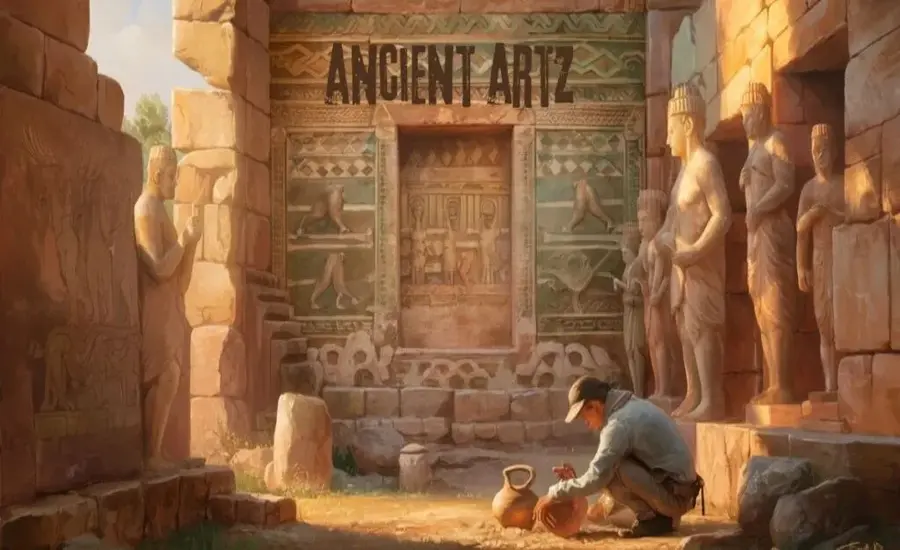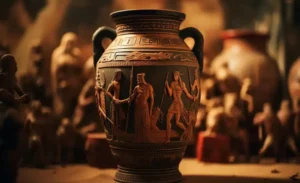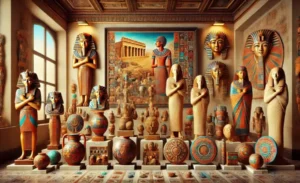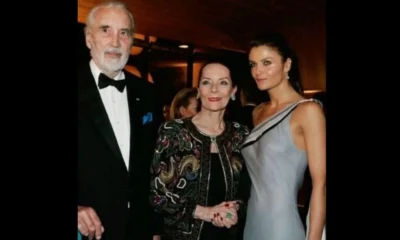General News
Ancient Artz: Timeless Beauty of Human Creativity

Art, in its many forms, has been the truest testament to human evolution, creativity, and expression. The legacy of ancient art stands as a profound reflection of our ancestors’ ability to communicate their beliefs, emotions, and cultural values through visual and tangible mediums. From intricate cave paintings to majestic architectural marvels, ancient art encapsulates the beauty and ingenuity of human creativity that has stood the test of time.
The Origins of Artistic Expression
The roots of artistic expression can be traced back to prehistoric times, where early humans sought to document their existence and make sense of the world around them. The earliest known artworks, such as the cave paintings of Lascaux in France and Altamira in Spain, are vivid examples of Paleolithic creativity. These depictions of animals, human figures, and abstract patterns were more than mere decorations—they were tools of storytelling, ritualistic practices, and survival education.
The techniques used in these ancient artworks demonstrate an impressive understanding of natural pigments and spatial awareness. Early artists used materials such as charcoal, ochre, and animal fat to create their masterpieces on stone walls. Despite the lack of sophisticated tools, these creations display remarkable detail, suggesting that art was deeply ingrained in the human psyche even in its earliest stages.
The Symbolism in Ancient Art
Symbolism played a crucial role in ancient art, allowing individuals and societies to convey complex ideas and emotions. In ancient Egypt, for instance, art was not merely decorative but also imbued with profound religious and cultural significance. The iconic depictions of gods, pharaohs, and hieroglyphics in Egyptian tombs and temples were designed to guide the deceased into the afterlife and honor their divine rulers.
The use of scale and color in Egyptian art was highly intentional. Gods were often depicted as larger than humans, signifying their supreme status, while vibrant hues symbolized different aspects of life and spirituality. For example, the color green represented fertility and rebirth, while gold signified eternal life and divine power. This meticulous attention to symbolism highlights the deep interconnection between art and the cultural fabric of ancient societies.

Mesopotamian Art: The Birthplace of Civilization
The Mesopotamian region, often referred to as the “Cradle of Civilization,” witnessed the emergence of some of the earliest urban centers and organized societies. This era gave rise to a rich artistic heritage characterized by monumental sculptures, intricate reliefs, and ziggurat architecture.
One of the most iconic examples of Mesopotamian art is the Stele of Hammurabi, which features one of the first codified legal systems. The relief depicts King Hammurabi receiving laws from the god Shamash, underscoring the divine authority attributed to rulers. Similarly, the Assyrian palace reliefs, which often depicted hunting scenes and military conquests, served to glorify the power and achievements of kings while offering a glimpse into the daily life and beliefs of the time.
The Timeless Elegance of Greek Art
Ancient Greek art is celebrated for its pursuit of beauty, balance, and perfection. The Greeks’ artistic achievements spanned sculpture, pottery, and architecture, leaving an indelible mark on Western civilization. The Parthenon in Athens, dedicated to the goddess Athena, epitomizes the Greek ideals of symmetry, harmony, and proportion.
Greek sculpture, particularly during the Classical period, showcased a profound understanding of anatomy and movement. Works such as the Discobolus (Discus Thrower) and the Venus de Milo exhibit an exquisite blend of realism and idealism, capturing the essence of human beauty and grace. Greek pottery, adorned with mythological narratives and daily life scenes, further reveals the creativity and storytelling prowess of this ancient culture.
The Grandeur of Roman Art
Building upon the foundations of Greek art, the Romans developed their distinct artistic identity characterized by grandeur and functionality. Roman art was heavily influenced by their pragmatic approach to architecture and engineering. The Colosseum, aqueducts, and triumphal arches not only demonstrate technical brilliance but also serve as enduring symbols of Roman authority and cultural dominance.
Roman sculpture often depicted emperors, military leaders, and ordinary citizens with striking realism. Busts and statues were created to preserve the likeness and legacy of individuals, offering a fascinating glimpse into the faces and personalities of ancient Rome. The use of mosaics to adorn floors and walls further highlights the Romans’ ability to combine aesthetics with practicality.
The Spirituality of Indian Art
Indian art, with its deep spiritual undertones, represents a harmonious blend of religion, philosophy, and creativity. The ancient temples of India, such as the Ajanta and Ellora caves, are adorned with intricate carvings and murals that narrate stories from Hinduism, Buddhism, and Jainism. These artworks are not merely decorative but serve as mediums of meditation and devotion.
The sculpture of ancient India, exemplified by the serene Buddha statues, embodies a sense of tranquility and enlightenment. The depiction of deities with multiple arms or heads symbolizes their divine attributes and cosmic energy. Similarly, Indian miniature paintings, which flourished during the Mughal period, showcase meticulous detail and vibrant colors, capturing scenes of royal court life, mythology, and nature.

Ancient Chinese Art: Harmony and Elegance
Chinese art, with its emphasis on harmony and balance, reflects the philosophical and cultural values of ancient China. The Terracotta Army, buried with the first Emperor of China, Qin Shi Huang, is a stunning example of artistic and engineering prowess. Each figure in this massive collection is uniquely detailed, highlighting the individuality and rank of the soldiers.
Chinese painting and calligraphy, often inspired by nature and Confucian ideals, exemplify the concept of “qi” or life force. Artists sought to capture the essence of their subjects rather than mere physical appearances. Traditional ink paintings of mountains, rivers, and bamboo evoke a sense of serenity and interconnectedness with the natural world.
Key Features of Ancient Art
- Symbolism and Spirituality
- Ancient art often conveyed religious and spiritual beliefs, serving as a bridge between the human and divine realms.
- Symbolic use of colors, motifs, and proportions enhanced the communicative power of these artworks.
- Material and Techniques
- Early artists used natural materials such as stone, clay, and pigments to create lasting masterpieces.
- Techniques evolved over time, from basic carvings to sophisticated frescoes, mosaics, and sculptures.
Preserving the Legacy
The preservation of ancient art is a testament to humanity’s reverence for its cultural heritage. Archaeological discoveries and conservation efforts have unveiled the stories of our ancestors and allowed us to appreciate the timeless beauty of their creations. Institutions, museums, and digital archives play a vital role in safeguarding these treasures for future generations.
Conclusion
Ancient art is more than an aesthetic achievement; it is a window into the soul of human civilization. It speaks of the creativity, resilience, and profound intellect of our ancestors. As we marvel at the timeless beauty of ancient art, we are reminded of the unyielding power of human creativity to transcend time, culture, and geography. This artistic legacy not only connects us to our past but also inspires us to continue exploring the boundless possibilities of human expression.
FAQs:
What defines ancient art?
Ancient art refers to creative works produced by civilizations from prehistoric times to the early Middle Ages. It includes cave paintings, sculptures, pottery, architecture, and other visual art forms that were created to reflect cultural, spiritual, and social values.
Why is ancient art important?
Ancient art serves as a historical record, providing insight into the beliefs, traditions, and daily lives of early civilizations. It is a testament to human creativity and innovation, influencing modern art and architecture.
What materials were commonly used in ancient art?
Materials varied by region but often included stone, clay, metals (bronze, gold), pigments from natural sources, and organic materials like wood and bone.
Which ancient civilization is most famous for its art?
Several civilizations are celebrated for their artistic achievements, including the Egyptians (hieroglyphics and pyramids), Greeks (sculpture and architecture), Romans (mosaics and engineering marvels), and Indians (temples and sculptures). Each contributed uniquely to the world of art.
How did ancient artists create their works without modern tools?
Ancient artists used basic tools made from stone, bone, and metal to carve, shape, and paint. They relied on innovative techniques and their understanding of natural materials to achieve remarkable precision and detail.
What role did religion play in ancient art?
Religion was central to ancient art. Many works depicted gods, goddesses, and mythological themes. Temples, sculptures, and murals were often created as offerings or to inspire devotion and reverence.
-

 Blog12 months ago
Blog12 months agoDiscover The World Of Movies With Mkvcinemas.com
-

 Biography12 months ago
Biography12 months agoMadeline Argy: Age, Height, and Family Background Revealed
-

 Tech12 months ago
Tech12 months agoSimpCityForum: One of the Most Interesting Online Communities
-

 Biography12 months ago
Biography12 months agoCelebrityMeet Christina Erika Carandini Lee?: All You Need To Know
-

 Biography11 months ago
Biography11 months agoMary Marquardt: The Woman Behind Harrison Ford’s Rise
-

 Biography12 months ago
Biography12 months agoHow Old Is SZA Daughter? Discover SZA Daughter’s Age, Name, and More
-

 Crypto Currency1 year ago
Crypto Currency1 year ago5starsstocks .com: How It’s Useful and Helpful
-

 Blog12 months ago
Blog12 months agoWhat is FilthyGrid? Exploring the World of FilthyGrid
-

 Health & Fitness12 months ago
Health & Fitness12 months agoWhat Has Kiolopobgofit in It? Exploring the Enigmatic Concept
-

 Biography12 months ago
Biography12 months agoChevy Chase Net Worth, Bio, Age, Height, Wife & Family

